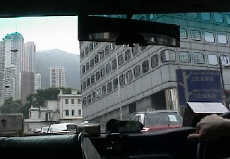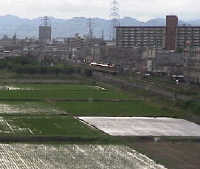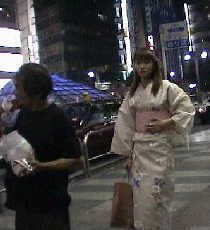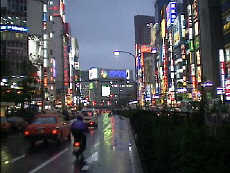June 15-21
Tokyo, Kyoto & Nara, Part I


Driving up Cotten Tree Drive to the steep hills of Mid-Levels.
![]()
![]()
In this story:
Another Day in Hong Kong
Arrival in Tokyo
Tokyo
Another Day in Hong Kong
If I felt like coming home to Saigon, I really felt like coming home arriving back in Hong Kong. This was my sixth time here in about 3 months! Hong Kong was my place to collect my mind, restock my supplies, and plan my next destinations. the beautiful new Chep Lap Kok airport; the airport express train; the taxi up steep Cotton Tree Drive, past the high school, to the steeper and winding roads of mid levels; passing under overpasses, winding between thin residential high rises and older low rises, with laundry hanging out to dry on special poles – by now it was a rush of nostalgia and relief of homesickness every time I came back.
I knew the airport almost like the back of my hand now. When arriving at the outer gates, I took the elevator (instead of the three rises of escalators) up from the mini-train that connected the outer gates to the inner gates. I learned that trick from the Cathay girls. It was a huge timesaver, and enabled you to get to immigration and the inevitable waiting before everyone else. Just before immigration, I would check the boards for my flight and baggage carousel number, before heading to the A or B side of immigration, so that I could exit right where my bags would be.
If I needed money, there was an ATM in the near right-hand corner (B side) of the arrivals hall after exiting customs. Then I would buy the round trip ticket (cheaper) at the airport express counter, and walk straight about 30 meters to the train that came every 10 minutes. If I had time and was hungry, I could stop by the McDonalds in-between the customs arrival gates (and I often did!).
On the train, I liked sitting on the outside seat farthest from the platform. You had a better view of the water that way. Then it was a pleasant 20-minute ride of lush waterfront, unloading docks and harbors, new condos, and urban cityscape built into the island hills. Arriving in Central, I headed to the latter taxi slots, as the first ones always filled up with people while the latter ones stayed empty. Then up to midlevels to unload my bags and drop off my laundry. Then a full night of email, writing, a little HTML. That was it this time. One day. A little sleep. And the next morning I was off again to the airport.


Rice fields below trains, high power lines, and residential apartments.
![]()
![]()
Arrival in Tokyo
It was much easier leaving in the morning without the traffic – right down Garden Road, past the US Consulate, the church, the botanical gardens, the post office. It took all of about 5 minutes. Being able to check in at the airport express station in Central made life so much easier. It was a pleasure to ride the 20-minute train out to the airport without having to lug your bags too. On the train and at the airport, the Cathay girls were everywhere in their sleek uniforms – Chinese collared red fitted jackets, with a yellow trimmed lapel pulled back, over short skirts. If I arrived early I could check my email at the free internet cafe just past gate 65. Or get some cha siu fan (roast pork over rice) in one of the airport cafes.
Did I mention how comfortable Cathay planes were, and how helpful their flight attendants are? They really made you feel welcome – and they were so sexy in their sleek uniforms. (I only hope restructuring efforts and the opening of HK routes do not change things for the worse.)
Unfortunately, I really needed more than a day to collect myself and get ready for the next leg. Travelling and trying to catalog my experiences were exhausting enough, not to speak of finding hotels, plotting train schedules, and planning my daily activities. It was a lot of work. Some of my friends may have thought I was relaxing and laying out in the sun, but after three months of travelling I was already burned out and tired. So arriving in Tokyo fatigued, in a thick drizzly fog, I already felt a little lost.
At Narita, security seemed to be pretty good. As I waited for my bag, I was surprised to see customs dogs sniffing around (but now after September 11th, I guess I should have been glad that even then there were safeguards.)
From my travel guides, by car, central Tokyo was about 2 hours away from the airport at Narita. And unless you wanted to sit in a taxi or bus for that long, the only alternative was taking the express train that took you right into Shinjuku. So I headed for the trains. Thankfully there was a convenient tourist information booth, and the perfect English-speaking attendant gave me maps and kindly pointed out the way.


A girl in traditional dress outside Shinjuku Station.
![]()
![]()
What she didn’t mention though were all the stairs! In New York I was used to just getting out of baggage claim and then jumping into waiting taxis. In Hong Kong, even though there was a train, the airport express picked you up just after baggage claim and customs, dropped you off in the middle of Central HK, and there were Cathay girls to greet you with luggage carts!
I only had a few pieces of luggage – my awesome but heavy Patagonia ETC bag, a Tenba carry-on backpack, and my Tenba laptop case. But I don’t know what people who had more would have done, since to get to the Narita Express and later out of Shinjuku Station, you had to walk up and down quite a few flights of steps. It was really strange to see so many people lugging their rolling suitcases up and down all those stairs.
The 40-minute Narita Express was efficient and comfortable, although sometimes crowded. Some people had to stand a good part of the way. However, it was a great way to see some of the Japanese countryside. It was raining, and the rice fields were lush, green, and everywhere. They were concentrated in some areas – with high power lines crisscrossing overhead; and segmented in others – between houses and buildings in residential areas, beside gas stations and industrial areas, and even under and around highway overpasses. You definitely got the sense that space was not to be wasted here.
Leaving Shinjuku station, I stepped out into modern-day Tokyo surrounded in a small canyon of neon signs and buildings fully covered with video panels. In the taxi, even though my hotel was not that far from the station, it took a little while to get the driver to understand where I wanted to go. We stopped a few times so that he could look at my map and get his bearings. It was a good thing I had picked out a hotel that was clearly marked in my Lonely Planet book. And the taxi ride? I think we traveled all of about 10 minutes for around $30! In New York, from the airport to Manhattan can be a good hour’s ride, and for “only” $35-45US. Ok, those were already two things that might deter visitors – the stairs and those high taxi fares!
I found my hotel on the edge of central Shinjuku and Kabukicho. It was small, but clean, with the lobby no bigger than a small elevator lobby, and crowded with vending machines. Each floor had about 8 rooms. The rooms themselves were tiny, but laid out neatly with a thin folded Japanese bathrobe on the bed and a pillow filled with plastic macaroni! It was strangely firm, but actually pretty comfortable. The bathroom, on the other hand, was about the size of a restroom in a plane or train. And I had thought that space in Hong Kong was precious. Itashimashite! Welcome to Tokyo!


The shimmering lights of Shinjuku.
![]()
![]()
Tokyo
Tokyo is less one central city, and more like a collection of smaller cities connected by a rail network (the Yamanote Line) that forms a ring around the center. In the middle of the ring is the imperial palace, with Ginza to the east, and modern Tokyo and the government buildings in Shinjuku to the west.
The cityscape is a sometimes strange mixture of modern and traditional architecture, connected with full-size streets and smaller winding bicycle alleys. As space is precious, establishments are really stacked on top of each other. Every floor, sometimes 10 stories up have places of business, beauty parlors, music stores, restaurants, bars, and massage parlors. You really have to look up at all the signs outside each building to see what is there, a little easier at night, as thin colored neon and fluorescent signs often light up the full height of buildings.
I spent my first days wandering around Shinjuku to get myself oriented, then explored some of the other districts like Ginza and Asakusa. Even though there were often signs in English as well as Japanese kanji, it was easy to feel a little lost. And sometimes, I found myself using a few different sources together to figure out where I was going (using a map in English with some kanji to figure out signs, maps, and machines labeled only in kanji). But after a few trips, getting around the subway was not too bad.
At night I roamed Kabukicho and was impressed by the number of couples in the streets. Or were they really? It seemed like everything was for sale. Girls, boys, boys dressed up as girls. I was a little surprised to hear a lot of Chinese being spoken. And even Shanghainese. At night, you could really see all the vending machines that were everywhere, late night street eateries, and even a great Shanghai dumpling place on the edge of Kabukicho: fried dumplings and zhun zhu lai cha (tapioca pearl milk tea) – my favorites!
In the morning, really sometimes it was noon when I would leave the hotel, I would stop by for some lunch at the local noodle shops. I felt like I was in the movie Tampopo – everyone slurping their soup, and an older woman literally running back and forth pouring tea, fetching chopsticks, sweeping. It was a little difficult to relax and eat peacefully with all that rushing about and slurping. but the noodles were pretty good I must say.
In Tokyo, there were few, if any, foreigners on the streets. I went through three days in Tokyo without hearing a word of English spoken on the streets. Only in Kyoto did I first hear a word in English on the streets. I guess the tourists came to see the more quaint historic sites, and not so much the ultra-modern Japanese cityscape.
Waking up late, going to sleep early, shooting almost nothing, I was tired now. I really felt it in Cambodia. Perhaps that was part of my negative feel from the country. From 10-12 rolls/day in Bali and Beijing and Shanghai, I had dropped to 8 in Vietnam, 4 in China, 2.5 in Cambodia, and now I was doing 2/day in Japan. It was harder to wake up early. And now I was getting up around 10 and getting out the door by noon. If I had been able to get up earlier, I would have been able to cover twice as much ground, but after three months of traveling I was more than exhausted, and even a little depressed. I just had to rally myself to keep at it.
The day before I went to Kyoto, I headed down to Akihabara to see the electronics neighborhood. As this was Japan after all, I was expecting to find a host of new gadgets here. But there were not as many as I had thought. Other than the mobile phones, most of what I saw was already available in New York at about the same prices.
Afterwards, I wandered down through Asakusa, and took a peaceful boat ride down the Sumida-gawa river as the sun was going down. it was a little industrial in places, but also so beautiful and relaxing as we glided on the water under a darkening sky, past modern buildings and shimmering colored lights.
For tons more pictures of Paul’s time in Japan and the rest of his Asia Journal, go to his web site.